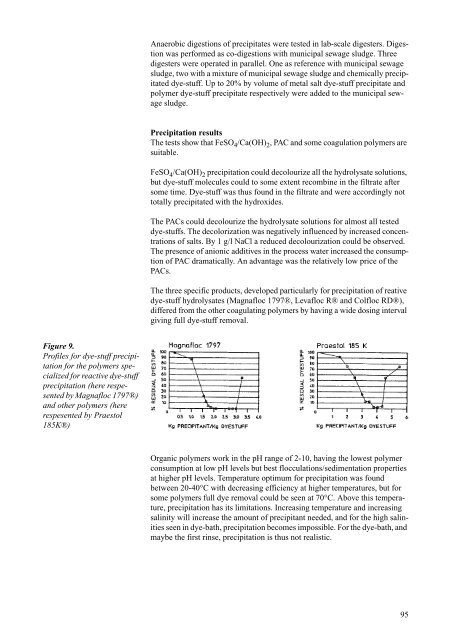Cleaner Technology Transfer to the Polish Textile ... - Miljøstyrelsen
Cleaner Technology Transfer to the Polish Textile ... - Miljøstyrelsen
Cleaner Technology Transfer to the Polish Textile ... - Miljøstyrelsen
Create successful ePaper yourself
Turn your PDF publications into a flip-book with our unique Google optimized e-Paper software.
Figure 9.<br />
Profiles for dye-stuff precipitation<br />
for <strong>the</strong> polymers specialized<br />
for reactive dye-stuff<br />
precipitation (here respesented<br />
by Magnafloc 1797®)<br />
and o<strong>the</strong>r polymers (here<br />
respesented by Praes<strong>to</strong>l<br />
185K®)<br />
Anaerobic digestions of precipitates were tested in lab-scale digesters. Digestion<br />
was performed as co-digestions with municipal sewage sludge. Three<br />
digesters were operated in parallel. One as reference with municipal sewage<br />
sludge, two with a mixture of municipal sewage sludge and chemically precipitated<br />
dye-stuff. Up <strong>to</strong> 20% by volume of metal salt dye-stuff precipitate and<br />
polymer dye-stuff precipitate respectively were added <strong>to</strong> <strong>the</strong> municipal sewage<br />
sludge.<br />
Precipitation results<br />
The tests show that FeSO 4/Ca(OH) 2, PAC and some coagulation polymers are<br />
suitable.<br />
FeSO 4/Ca(OH) 2 precipitation could decolourize all <strong>the</strong> hydrolysate solutions,<br />
but dye-stuff molecules could <strong>to</strong> some extent recombine in <strong>the</strong> filtrate after<br />
some time. Dye-stuff was thus found in <strong>the</strong> filtrate and were accordingly not<br />
<strong>to</strong>tally precipitated with <strong>the</strong> hydroxides.<br />
The PACs could decolourize <strong>the</strong> hydrolysate solutions for almost all tested<br />
dye-stuffs. The decolorization was negatively influenced by increased concentrations<br />
of salts. By 1 g/l NaCl a reduced decolourization could be observed.<br />
The presence of anionic additives in <strong>the</strong> process water increased <strong>the</strong> consumption<br />
of PAC dramatically. An advantage was <strong>the</strong> relatively low price of <strong>the</strong><br />
PACs.<br />
The three specific products, developed particularly for precipitation of reative<br />
dye-stuff hydrolysates (Magnafloc 1797®, Levafloc R® and Colfloc RD®),<br />
differed from <strong>the</strong> o<strong>the</strong>r coagulating polymers by having a wide dosing interval<br />
giving full dye-stuff removal.<br />
Organic polymers work in <strong>the</strong> pH range of 2-10, having <strong>the</strong> lowest polymer<br />
consumption at low pH levels but best flocculations/sedimentation properties<br />
at higher pH levels. Temperature optimum for precipitation was found<br />
between 20-40°C with decreasing efficiency at higher temperatures, but for<br />
some polymers full dye removal could be seen at 70°C. Above this temperature,<br />
precipitation has its limitations. Increasing temperature and increasing<br />
salinity will increase <strong>the</strong> amount of precipitant needed, and for <strong>the</strong> high salinities<br />
seen in dye-bath, precipitation becomes impossible. For <strong>the</strong> dye-bath, and<br />
maybe <strong>the</strong> first rinse, precipitation is thus not realistic.<br />
95

















